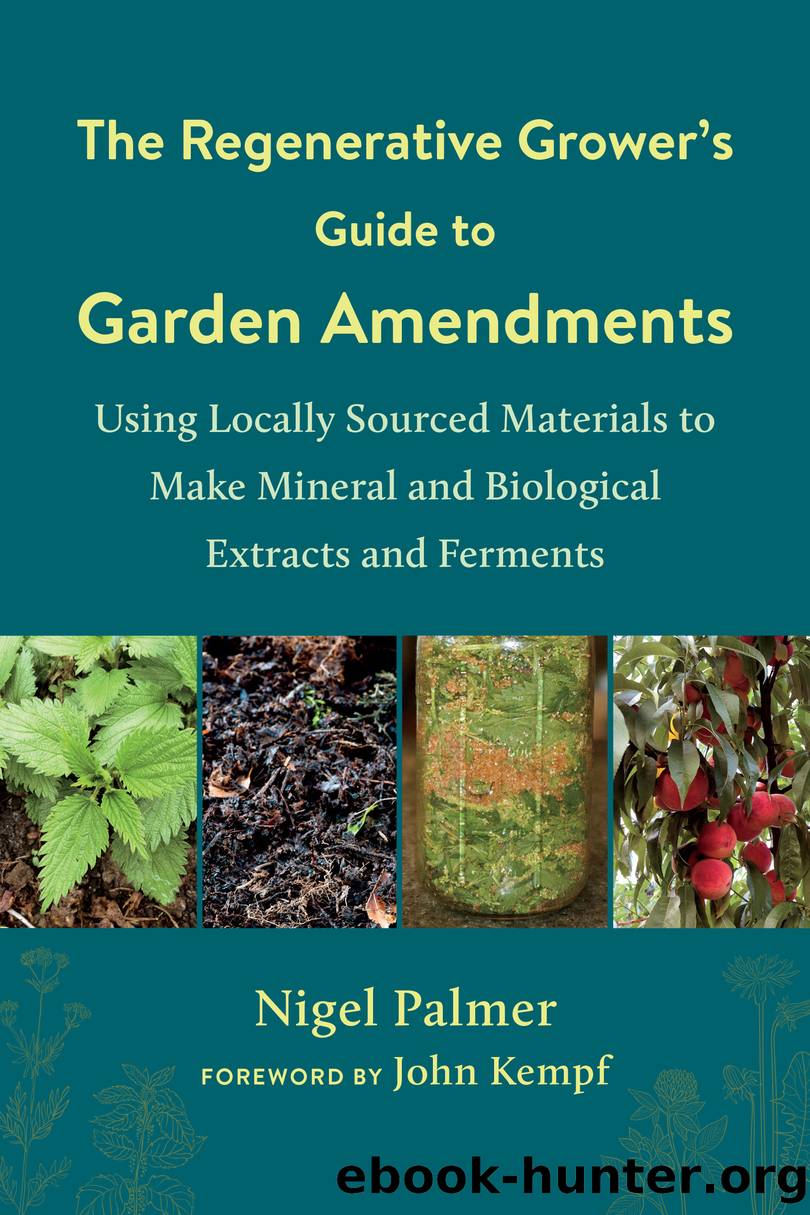The Regenerative Grower's Guide to Garden Amendments by Nigel Palmer

Author:Nigel Palmer
Language: eng
Format: epub
Publisher: Chelsea Green Publishing
A simple mister-type spray bottle or a manual pressurized pump spray bottle works well for applying foliar sprays in home gardens.
Schedules for foliar spraying may vary depending on many factors. One possible schedule is to simply foliar spray all crops every 7 to 10 days using a broad-spectrum mineral amendment. For fruit trees, a basic guideline is to apply a foliar spray once in the fall, again in early spring, and another time during fruit-set. Sometimes I choose to spray on a windy day, knowing that everything downwind of the sprayed area will also benefit from the application.
Making and Applying a Foliar Spray
I use an electrical conductivity meter when mixing foliar sprays. The electrical conductivity of rainwater is close to zero, but the mineral amendments recipes I use are loaded with ions that increase the conductivity of the solution considerably. The recommended dilution rates for these amendments are 1:500 (amendment:water) or 1:1000. Even at these dilution rates, the electrical conductivity of the solution will increase with each additional type of amendment added. Conductivity is measured in millisiemens per centimeter (mS/cm). I monitor the electrical conductivity as amendments are added, and in my experience solutions that have values between 1.5 and 2.5 mS/cm do not seem to burn plant tissue.
Foliar sprays have a tendency to ball up on the plant surface because of the surface tension of water, but it is desirable for the spray droplets to spread out on the leaf for better absorption. One way to overcome surface tension is to add a wetting agent to the spray. I’ve found, though, that foliar sprays made with homemade amendments and rainwater do not have this tendency to bead up. This may also result from the particular way in which I mix the spray solution in a bucket with magnets mounted on it, as described earlier in this chapter. The surface tension of water is reduced when exposed to magnetic fields in this manner—the structural change of the water molecules acts as a kind of wetting agent. The water also becomes more stable and accelerates plant growth. It is interesting to read research papers on this subject, and I’ve included some in the bibliography.
Download
This site does not store any files on its server. We only index and link to content provided by other sites. Please contact the content providers to delete copyright contents if any and email us, we'll remove relevant links or contents immediately.
Turbulence by E. J. Noyes(7081)
The Thirst by Nesbo Jo(5819)
Gerald's Game by Stephen King(3943)
Be in a Treehouse by Pete Nelson(3245)
Marijuana Grower's Handbook by Ed Rosenthal(3139)
The Sprouting Book by Ann Wigmore(3068)
The Red Files by Lee Winter(2928)
The Remains of the Day by Kazuo Ishiguro(2635)
Sharp Objects: A Novel by Gillian Flynn(2462)
Christian (The Protectors Book 1) by L. Ann Marie(2400)
Organic Mushroom Farming and Mycoremediation by Tradd Cotter(2318)
The Culinary Herbal by Susan Belsinger(2071)
Stone Building by Kevin Gardner(2003)
The Starter Garden Handbook by Alice Mary Alvrez(1937)
Lilac Girls by Martha Hall Kelly(1891)
The Unlikely Pilgrimage of Harold Fry by Rachel Joyce(1846)
The Lean Farm Guide to Growing Vegetables: More In-Depth Lean Techniques for Efficient Organic Production by Ben Hartman(1794)
Urban Farming by Thomas Fox(1760)
Backyard Woodland by Josh VanBrakle(1597)
